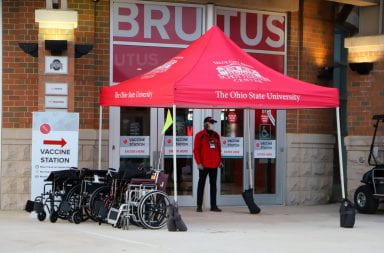Hometowns can be a laboratories, and small cities can inspire discoveries. This is what an Ohio State student experienced over the summer.
Andrew Hutchman, a third-year in atmospheric sciences and civil engineering, conducted research on his hometown of East Liverpool, Ohio, to study urban heating and its impact.
Hutchman said cities are always hotter than surrounding areas because of the materials used to build buildings, which line each other in close proximity, creating a phenomenon called the “heat island” effect. In recent years, the combination of urban heating and global warming has threatened human health. According to a Climate Central report in 2014, Columbus is among the top 10 cities in the U.S. with the most intense difference between the city and rural areas.
“The urban heat island generally is a problem because during the night, people are getting really dehydrated and sick,” Hutchman said. “They are not drinking water because sun is down, but it’s still really hot out,” said Hutchman. “So we are just trying to contribute to the general understanding of what’s going on.”
Aaron Wilson, a researcher in the OSU’s Byrd Polar and Climate Research Center and Hutchman’s adviser, said urban heating affects not just human health, but also the environment.
“There are links between heating and perhaps declination of water quality and watersheds,” Wilson said.
Hutchman is taking further steps to apply his discoveries to more cities, with help from Wilson. They hope this study can influence governments’ decision making in urban planning, in an attempt to solve the urban heating issue.
Hutchman’s study specifically focused on cold-air pooling, which is a topographic effect occurring at night.
Normally, higher places are cooler than lower places. But cold air is heavier than hot air. So at night, cold air goes down and hot air goes up, ending up with higher areas becoming warmer than lower ones.
Hutchman said there are many existing studies on cold-air pooling. While most studies are conducted in only big cities where the terrains are flat, he looked into small towns with more terrain variety.
“If it (urban heating) impacts small cities this much, it impacts bigger cities as well,” Hutchman said.
During this summer, Hutchman tested this effect on his hometown where same-sized urban centers are located both on the hill and on the valley. He studied the temperature differences between these two centers.
Hutchman discovered that on calm nights, the center on the valley is colder and cools down faster than the center on the hill. On windy nights, the temperatures of the center on the hill and in the valley are relatively the same.
Wilson said the concept of urban heating leads to policy challenges for cities.
“It impacts decisions which the city of Columbus has to make in terms of opening up cooling centers for its residents to be able cool off,” he said. “There are also some decisions going on about how do we build our buildings with materials that mitigate the amount of warming we are seeing. How can we make Columbus a greener city?”


